From late November 2017, Animal Crossing: Pocket Camp–Nintendo’s latest smart device offering–will be available for download on the Play Store/Apple Store in major territories. Besides Pokémon (which we already have the Niantic-developed Pokémon Go), Animal Crossing is perhaps Nintendo’s biggest chance to appeal to the humongous casual audience that plays daily on their smartphones and tablets.
Since its inception, the Animal Crossing series has been a massive success for Nintendo, especially on the DS and 3DS, where the titles have each sold over 10 million copies worldwide. The blend of a slow village life that you can lose yourself in and a cast of quirky animal inhabitants has resonated extremely well with all types of players. Now imagine what happens when the entry requirements are effectively removed…
Although the game officially launches in late November, our friends down under, in Australia, have been able to play version 0.9 of the game since late October. Your author has also become a, ahem, “temporary resident” of Australia to try out the game and bring to you first-hand impressions of this new Animal Crossing experience. However do note that the official launch (presumably 1.0) may have additional features not mentioned.
In case you missed the announcement Direct, Pocket Camp is another free-to-play game like Miitomo and Fire Emblem Heroes, rather than a paid offering like Super Mario Run. Instead, the game makes money off optional micro-transactions. In this case, Leaf Tickets, which can be used to purchase exclusive (but optional) items and basically speed up gameplay. This should make it even more accessible for a wider audience.
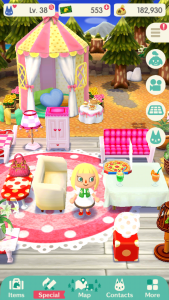
A mixture of familiar and brand new furniture are included.
The game itself is 100% Animal Crossing, down to the looks, sounds and general gameplay. As with Nintendo’s other mobile adaptations, the game plays in portrait mode and outputs at a pleasantly high resolution. The result is a very polished looking game that could easily pass for a mainline Animal Crossing. At the time of writing, it even has better graphics than most other titles (which makes us drool about a potential Switch version).
At the beginning, as with previous games, you’re asked to design your character. The options available are all standard, but you now have the option to alter your character’s skin colour, which is a very welcome addition. Furthermore, while you cannot change your character’s name and gender midway through the game, you can change everything else, including your eyes, hair and hair colour. Perfect if you’re bored and want a new look!
Soon afterwards, you’ll be inaugurated as the manager of the game’s eponymous campsite, which itself is loosely based off the campsite added to Animal Crossing New Leaf‘s Welcome amiibo update. This time, the campsite essentially functions as your “house”. You can fully customise your campsite using furniture, just like it were a room in a normal Animal Crossing game. Positioning furniture is exactly the same as in newer games.
On top of this, you can add up to two amenities, which are basically like the big Public Works projects in New Leaf. These range from good ol’ tents to the weird and wacky. The purpose of sprucing up your campsite is so you can invite animals to stay there. They are very picky about your tastes, you see. Besides that, it always feels great to put together a stunning camp site that really shows off your personality–and to, literally, show off.
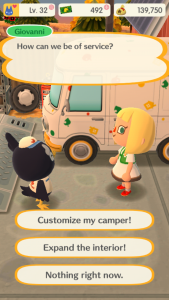
It wouldn’t be an Animal Crossing if you couldn’t take out a loan…
In addition, you can customise both the interior and exterior of your camper van, which you use to travel around. The interior basically functions like another room, so you can fill it with fancy furniture. Heck, you can even expand the interior and add an extra floor (by taking out an loan), just like your house in the main games. The exterior changes are limited to the van type and paint job. All of these changes are done in a new location called OK Motors.
None of this is possible without some hard work though. Obviously, you need money for everything, but now you need materials to make furniture and amenities–by that, we mean lots of materials. These can be earned by completing animal requests. Outside your campsite, you can visit various tourist sites, including a river, orchid, beach and tropical island. Here, you can harvest items and meet friendly animals and even other campsite managers.
Just like the main games, the animals are all lazy buggers–lovable lazy buggers, mind–who need help getting the simplest thing like an apple, or an insect or a fish. Thankfully, these things are all found in the tourist spots. You’ll find fruits in the orchid, fish in the river and sea and bugs on the island. Gathering these is exactly the same as in the other games, although you now always have your gathering tools automatically out.
Fulfill an animal’s request and you’ll earn money, materials and friendship points. The latter is used to increase your character’s Level. As your Level rises, you will be able to meet more animals, get increased storage space and have more furniture to make. Therefore, you’ll want to help as many animals as possible. Even if it means becoming a proverbial slave to them before long. Because, by gosh, we’ll do anything to THAT piece of furniture!
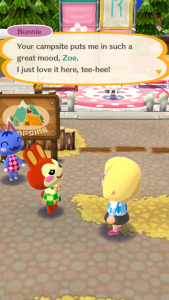
Become friendly enough and you can invite animals to your campsite.
Besides the animals, you can speak to aspiring campsite managers like yourself. Doing so allows you to add them as friends, check their market boxes or visit their campsite. Having friends is always useful. Besides letting you keep tabs on them, you need the daily help of multiple friends to enter a place called Shovelstrike Quarry, where you can earn money and rare materials.
Any items you don’t need, you can put into a market box. Players who meet you in the game can then buy these items. Similarly, if you’re lacking an item for an animal’s request, you may find it in another player’s market box. Sadly, at this point in time, only request items can be traded, not furniture or clothes. Finally, visiting other campsites is great for getting inspiration, just like the Dream Suite or Happy Home Academy in New Leaf.
Once you’ve acquired all the relevant materials, you can directly order furniture and amenities from Cyrus, of Re-Tail fame. He will then give you a work slot and specify how much time (in hours) the project will take. This can be as short as a few minutes, maybe a few hours–or in extreme cases (for an amenity), up to 72 hours. Hey, it’s not easy making these things for multiple customers!
Now this where the micro-transactions start to come into play. Those of you who don’t mind waiting, that’s perfectly fine. Animal Crossing has always been a game where things gradually happen–and we’ve already had Public Works projects requiring a day to be built. But if you’re impatient or want to get things done quick, you can use Leaf Tickets to make Cyrus complete the piece of furniture or amenity instantly.
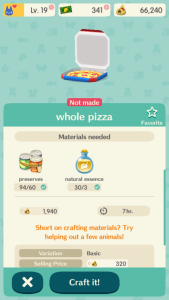
Don’t call Cyrus if you’re hungry, or you could be waiting for a while.
That’s not all Leaf Tickets are used for. They can also be used to buy items that assist with gathering fish and insects. Normally you must catch fish and insect one by one, but by using a net or honey, you can catch up to 10 at once. Which can be useful since fish/insects respawn fairly slowly. Likewise, they can be used to grant instant access to Shovelstrike Quarry, expand your inventory space, number of market boxes and even Cyrus’s work slots.
At the time of writing, there are some aesthetic items only available with Leaf Tickets, including chairs to summon KK and Tom Nook to your campsite, as well as paint jobs for your camper van. While Leaf Tickets can be bought with real money, you can earn some by leveling up and completing milestones while playing the game. So far, your author has racked up 500+ after playing for around 3 weeks.
Well, that’s about it for the main gameplay components. On paper, you have most of the things that make Animal Crossing such a fascinating experience–the daily rewarding grind, the lovable animals with their funny conversations, and the furniture/clothes/fish/insect collecting, all wrapped in a cutesy world that’s brimming with colour and character. That said, in practice, just how well has the game transitioned to this mobile format?
Having spent 3 weeks or so playing Pocket Camp for a good portion of time, we think that it’s a fantastic little Animal Crossing that you can really enjoy in short doses. However it currently lacks the infrastructure to make it a true replacement for one of the core games, and we’re concerned if it’ll hold attention for long. Naturally, this may change as more features and events are constantly rolled out.
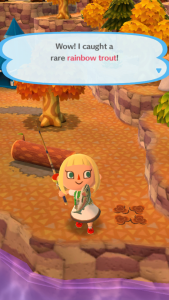
You can experience some truly Animal Crossing moments.
Firstly, the good. We can’t stress enough, but Nintendo has made a fantastic adaptation, with appealing visuals and incredibly intuitive UI and controls. Crucially, the animals’ dialogue is top-notch and at least on par with the likes of New Leaf. There is also a decent variety of things to do and collect. For a free game, you can get a lot of mileage and as the potentially first Animal Crossing for many, they could do a lot, lot worse.
Now, the bad. Ironically, it’s not the micro-transactions or even the grind that holds the game back, but the current lack of things to do and the dawning realisation of how repetitive the game is. While repetition isn’t uncommon in the main games, it’s intensely magnified here due to the gameplay loop. You’ll eventually visit the same places over and over again and you’ll speak to the animals so often, you’ll learn all their speech patterns.
Though Pocket Camp may not be the definitive Animal Crossing by a large margin, honestly that’s probably not its intention. Plus it’s gotten us nostalgic about the main games–and super excited at what Animal Crossing on the Switch will bring to the table. Which we’re guessing is part of Nintendo’s long-term plan. If so, that part of their plan seems to have worked, for us anyway!
Fingers crossed, if Nintendo can consistently update Pocket Camp with top-quality content over the course of its (hopefully) long life, much like they’ve recently done with Fire Emblem Heroes, our initial worries should be cleanly swept away. In that scenario, Animal Crossing fans will have a very bright future to look forward to! Well, that’s all for now; here’s hoping we see you on the campsite soon!